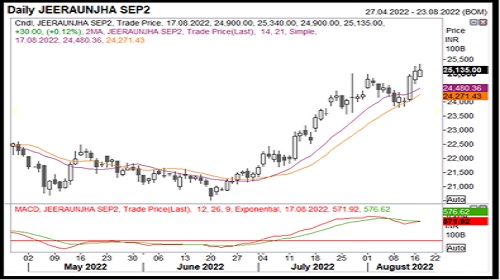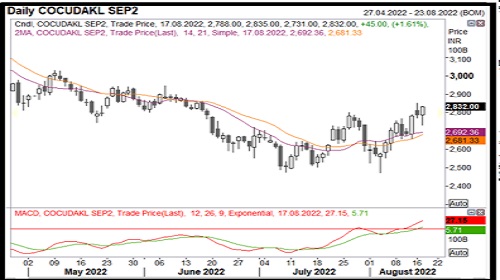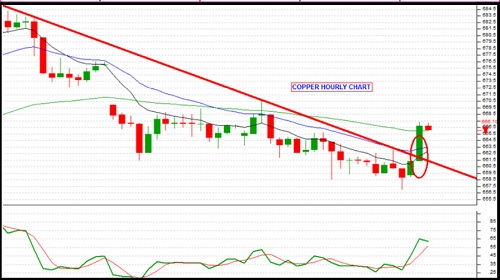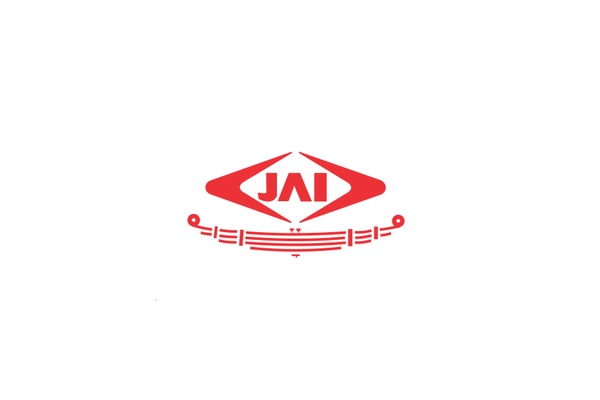Agri Commodity Technical Report 18 August 2022 - Geojit Financial Services

SPICES:
• A mixed trend was seen in spices complex on NCDEX on Wednesday. Jeera futures continued rising and hit a fresh record high on fall in production in 2021-22 rabi season. Coriander futures too inched higher, while turmeric futures ended down on tepid demand.
• Production of spices in India is likely to have declined 1.5% on year to 10.9 mln tn in 2021-22 (Jul-Jun), according to data from Spices Board India. The country had produced 11.0 mln tn of spices in the previous year. Among the complex, a major rise in production was pegged in turmeric. The board has pegged turmeric production at 1.33 mln tn, up 18.4% on year. Jeera production was seen at 725,651 tn, down 8.8% on year due to lower acreage in Rajasthan and Gujarat, the key producer. Production of chilli, counted as one of the largest exported and produced spices in the country, is projected at 1.9 mln tn, compared with 2.0 mln tn a year ago. Production of pepper is seen at 60,000 tn, down 7.7% on year, while the output of small cardamom is seen rising by 3.6% on year to 23,340 tn, data showed.
• According to fourth advanced estimates by Gujarat government, jeera production is seen fall by 44.5 per cent to 221500 tonnes in 2021-22 on yoy basis, while that of coriander is seen at 208090 tonnes, down by 5.9 per cent during the same time period.
• Govt. sees spices output in 2021-22 at 10.9 million tonnes vs 10.8 million tonnes.
• The export of spices from India during 2021-22 declined nearly 13 per cent on year to 1,531,154 ton, according to data from the Spices Board India. In terms of value, exports dipped by about 1.25 per cent to 3,057,644.24 rupees. Export of chilli, turmeric, jeera, coriander, fenugreek declined, while that of pepper, cardamom, ginger and fennel rose.
• India exported 153,154 ton of turmeric in in FY 2021-22, down 16.70% on year. Coriander exports were down 15.16% on year at 48,658-ton, data showed.
• The exports of jeera during declined 27.28% on year to 216,996 ton. Export of small cardamom jumped by 63 per cent to 10,572 ton year on, while that of pepper rose 9.5 per cent.

COTTON:
• The US Department of Agriculture has scaled down its estimate for the global cotton production in 2022-23 (Aug-Jul) to 117.0 mln bales (1 US bale = 218 kg) from 120.1 mln bales projected a month ago. The cut in the estimate is attributed to a lower production in the US, the agency said in its World Agricultural Supply and Demand Estimates report for August. Production in the US is seen lower due to a severe drought, which is likely to affect the yield. Texas, the largest cotton-producing state in the US is likely to harvest 2.9 mln bales of cotton this year, compared to 7.7 million bales in 2021. Production in the US is estimated at 12.6 mln bales in 2022-23, which is sharply lower from 17.5 mln bales a year ago. Global cotton consumption is now seen at 119.1 mln bales in 2022-23, against an estimate of 119.9 mln bales a month ago, owing to a fall in demand from Turkey, Pakistan, Bangladesh, and Vietnam. Global exports are estimated at 44.6 mln bales, against 46.4 mln bales projected a month ago. The agency has lowered its 2022-23 global ending stocks estimate to 82.8 mln bales. For India, the agency has maintained its estimate for production in 2022-23 at 27.5 mln bales. The domestic consumption estimate is seen at 25.0 mln bales. Exports are also maintained at 3.7 mln bales. Cotton ending stocks in India for 2022-23 are now seen at 8.8 mln bales, higher than 8.4 mln bales projected a month ago, it said.
• The area under cotton across the country in the 2022-23 (Jul-Jun) season was over 12.3 mln ha as of Thursday, up 6% from a year ago, data from the farm ministry showed. Sowing has been completed in the northern states and the acreage in Haryana, the top producer in north India, fell 5.5% on year to 650,500 ha. In Punjab, it fell 2.4% on year to 248,000 ha.In Gujarat, acreage rose to 2.5 mln ha, against 2.2 mln ha a year ago. In Maharashtra, the area under the crop increased 7.6% on year to 4.2 mln ha, while in Telangana, it fell 5.2% to 1.9 mln ha.
• The government has taken many steps to counter the recent hike in cotton prices and so "there is no proposal at present to remove cotton from the Multi Commodity Exchange of India," Minister of State for Finance Pankaj Chaudhary said in response to a question in the Lok Sabha today. Cotton and cotton yarn prices are dependent on demand and supply and international prices. Recently, an overall upward trend has been observed in cotton and cotton yarn prices with some fluctuations, he said. Domestic cotton prices have risen nearly 50% this year due to tight supply. A rise in domestic mill consumption and a sharp decline in production have led to a drop in ending stock estimates, market participants said. Cotton production is likely to drop to 31.5 mln bales in the current crop year ending June compared with 35.2 mln bales in 2020-21, according to the third advance estimate by the farm ministry. In July, the government extended the exemption of basic customs duty and the agriculture infrastructure and development cess on the import of raw cotton by a month till Oct 31. The extension of duty-free import of cotton is expected to benefit the country's textile, fabric and garments industry, while also providing relief to consumers. Further, the Ministry of Textile has formed a Textile Advisory Group, an informal body to deliberate and recommend suitable measures on issues pertaining to the entire cotton value chain. This advisory group constantly engages with various stakeholders across the cotton value chain, which includes MCX, on the issues of cotton and cotton yarn prices. MCX recently increased the additional margin on August cotton contract to 11% from 6% earlier. Further, the daily price limit for August contract has been narrowed to 2%.
• The Multi Commodity Exchange of India has increased additional margin on August cotton contract to 11% from 6% at present, the exchange said in a circular. The increase in additional margin, to check price volatility, will be effective Monday. The bourse has also revised the daily price limit for August contract, effective Monday. "The Daily Price Limits for cotton August expiry futures contract will be narrowed to 2% with no further relaxation in the daily price limit thereafter," the exchange said. However, there will be no change in daily price limit in other contracts of cotton, which is the new season contract from October onwards, it said.

OTHERS:
• The National Commodity and Derivatives Exchange said it has advanced the expiry of August castor contract to Aug 17 from Aug 18, "on account of closure of the physical market at the basis centre, Deesa on Aug 18." Deesa in Gujarat is the main delivery centre for castor contracts on the NCDEX. Accordingly, the staggered delivery period shall commence from Aug 10, the bourse said in a circular. Agriculture and Agri-Food Canada has revised its production estimate downwards for masur in 2022- 23 (Aug-Jul) to 2.46 mln tn, 16.3% lower than last month's forecast, due to a likely decrease in sowing area, it said in a report for July.
• Canada's farm agency projected acreage of masur in 2022-23 at 1.75 mln ha, 8.2% lower than the previous month's outlook. Agriculture and Agri-Food Canada is a Canadian government agency responsible for policies governing the production, processing, and marketing of all farm, food, and agri-based products. Similarly, output of dry peas is pegged lower at 3.30 mln tn in 2022-23 from 3.50 mln tn projected in June, as producers across the country are likely to decrease the sowing area. Acreage of dry peas in 2022-23 is estimated at 1.36 mln ha, 16.9% lower than last month's outlook, the report said. Production of dry beans is also seen decreasing 12.3% at 285,000 mln tn in 2022-23, while that of chana is predicted to rise 1.8% to 112,000 mln tn due to improved yields, according to the report.
• The Securities and Exchange Board of India has asked the National Commodity and Derivatives Exchange to not launch any new chana contracts on its platform till further notice, the market regulator said in a release on August 16, 2021.
• According to the Rajasthan State Agriculture dept., as of 5 August 2022, area under guar stood at 2971.56 thousand hectares, 118.86 per cent of the targeted 2500 thousand hectares. Last year, during the same time period farmers had sown 1701.29 thousand hectares.
• India’s Guar gum exports increased in the month of June’2022 by 5.36% to 29,236 MT compared to 27,748 MT durin g previous month. However, the gum shipments were up by 56.28% in June’2022 compared to the same period last year. Out of the total exported quantity, around 7971 MT (27.27%) bought by US, Russia bought 3,905 MT (13.36%), China 3,681 MT (12.59%), Germany 3,112 MT (10.64%). Export demand was driven by bullish crude oil prices. We expect Guar export in July’22 at 25,000- 28,000 tonnes. India’s Guar split exports increased in the month of June’2022 by 61% to 8,620 MT as compared to 5,347 MT previous month. However, the Guar split shipments down by 4.39% in June’22 compared to the same period last year. Out of the total exports, around 7,300 MT (84.69%) bought by China, US 860 MT (9.98%).
• Global production of natural rubber in July stood at 1.28 mln tn, up 3.9% from the same period a year ago, the Association of Natural Rubber Producing Countries said in a report. Global consumption of the commodity is estimated to have grown 8% to 1.27 mln tn in July.

OIL AND OILSEEDS:
• India's exports of oilmeals rose 18.6% on year to 227,247 tn in July, according to data released by The Solvent Extractors' Association of India today. During the first four months of the financial year that began on Apr 1, exports of oilmeals rose 34.6% on year to 1.2 mln tn. The rise in exports of oilmeals was mainly attributed to the surge in exports of mustard meal, which spiked to 851,212 tn in Apr-Jul from 479,572 tn in the year-ago period. However, in case of soymeal, exports remained subdued as "India is out priced in the international market," the association said in a release. Exports of soymeal plunged to 90,711 tn in Apr-Jul compared with 144,782 tn a year ago. During Apr-Jul, South Korea imported 424,719 tn oilmeals from India, compared with 277,034 tn a year ago, and Vietnam imported 226,606 tn against 164,115 tn a year ago, the association said. During the first four months of the new fiscal, 477,415 tn of oilmeals were exported from Kandla port, and 321,345 tn from Mundra port. Exports from the Mumbai port, including the Jawaharlal Nehru Port Trust, were at 69,586 tn, while 137,538 tn were shipped from Kolkata port and 242,628 tn from other ports, the association also said.
• The US Department of Agriculture in its August report has projected global oilseed output for 2022-23 (May-Apr) to rise to 646.0 mln tn from 643.1 mln tn projected in the previous month. The agency said higher output of soybean, rapeseed, and sunflower seed crops are likely to push up the overall production. The agency has projected global soybean output to rise by 1.39 mln tn to 392.8 mln tn. Production of Brazil's 2022-23 soybean crop is estimated at 149 mln tn, and that of Argentina's crop at 51 mln tn, unchanged from the agency's July projections. The department estimates soybean production in the US at 123.3 mln tn, compared with 122.6 mln tn in the previous month. Brazil is the top producer of soybean worldwide, followed by the US and Argentina. The agency has scaled down its estimate for soybean's global ending stocks for 2022-23 to 101.4 mln tn, from 99.6 mln tn estimated in July, with most of the increases in Brazil, Argentina, and the US. Estimate for global soyoil production for 2022-23 has also been revised upwards to 61.6 mln tn from 61.5 mln tn predicted in the previous month. Moreover, the estimate for global soyoil exports in 2022-23 has been revised marginally higher to 12.9 mln tn from 12.8 mln tn. The department projected global soymeal output for 2022-23 at 257.3 mln tn, up from 256.8 mln tn on month. The estimate for global exports of soymeal in 2022-23 is a tad higher at 70.1 mln tn, compared with 69.9 mln tn pegged the previous month, it said. Soymeal is a derivative of soybean, manufactured by crushing the oilseed, and is mainly used in producing poultry feed. The agency also raised the production estimate for sunflower in Russia by 1.5 mln tn to 15 mln tn, which is seen pushing up the total global oilseed output.
• India's 2022-23 (Jul-Jun) kharif acreage fell 3.8% from a year ago to 96.4 mln ha so far, the farm ministry's data showed. This was mainly due to weakness in sowing of key crops such as rice, maize and oilseeds. In the ongoing 2022-23 (Jul-Jun) kharif season, farmers have sown, as of last Thursday, soybean across 11.9 mln ha, up 1% from a year ago, latest data from the farm ministry shows. Soybean acreage in Madhya Pradesh, the country's top producer, is down 7.3% on year at 5.0 mln ha, while that in Maharashtra, the second-biggest producer, it is up 6.7% at 4.7 mln ha. In Rajasthan, the acreage is up 11.2% at 1.14 mln ha, data shows.
• India's soymeal exports in July rose 3.4% on year to 30,000 tn, the Soybean Processors Association of India said. For Oct-Jul, soymeal exports plunged to 586,000 tn from 1.9 mln tn in the year-ago period. Soymeal is primarily used as poultry and livestock feed. Indian soymeal is nongenetically modified and considered rich in protein. In July, production of soymeal rose to 599,000 tn from 479,000 tn a year ago, while the output for Oct-Jul was at 5.39 mln tn, down from 6.98 mln tn in the year-ago period, SOPA said. Soybean arrivals in spot markets totalled 700,000 tn in July, up from 500,000 tn a year ago. However, during Oct-July, arrivals fell to 8.20 mln tn from 9.03 mln tn in the year-ago period. By the end of July, mills, traders, and farmers were left with around 4.05 mln tn of soybean stock, the association said.
• Malaysia's crude palm oil output rose 1.8% on month to 1.6 mln tn in July, data from the Malaysian Palm Oil Board showed. Export of palm oil in July rose 10.7% on month to 1.3 mln tn, while outbound shipments of biodiesel declined 39.2% on month to 14,401 tn, the data showed. Palm oil is used to manufacture biofuel. The total stocks of palm oil in the country rose 7.7% on month to 1.8 mln tn as of Jul 31. Malaysia is the world's second-largest producer of crude palm oil, and India is the largest consumer of edible oils in the world.
• The Punjab state government will launch a 'yellow revolution' to boost production of mustard seeds, Jitendra Jorwal, deputy commissioner of the state's Sangrur district, said at an event. The state had organised a meeting of farmers at Sangrur on Saturday to encourage them to diversify from wheat to mustard in the coming rabi season. "Punjab farmers shall diversify crops like mustard from wheat, that will provide double benefits of water conservation and financial support," Jorwal said. Farmers could avail additional financial benefits by registering on modern farms and switching to mustard crop plantation, he said. The 'yellow revolution' would start from Sangrur district and gradually cover the entire state. Through this, the country could save 1.5 trln rupees, which is spent on importing edible oils annually, Ricela Group Chairman A.R. Sharma said. So far, over 200 farmers from Sangrur district have shown interest in joining the mustard mission. A similar project has been launched in Rajasthan and Madhya Pradesh with the help of the Solvent Extractors' Association of India and Solidaridad.
• China's securities regulator has approved trading of soybean and soyoil options on the Dalian Commodity Exchange, it said on Friday. Options trading for the Dalian exchange's soybean contracts and its soyoil contract will begin on Aug. 8, the China Securities Regulatory Commission (CSRC) said in a statement. This adds to the exchange's existing agriculture products options such as soybean meal, corn and palm olein. The Dalian exchange also has options for other contracts such as iron ore and liquefied petroleum gas. China is the world's top importer of soybeans and largest consumer of various raw materials.
• The government had on Jul 15 issued guidelines to prevent misdeclaration of net quantity on edible oil by manufacturers, packers and importers and to ensure packaging standards, a notification by the Ministry of Consumer Affairs, Food and Public Distribution said. The guidelines have been issued after the Solvent Extractors' Association of India had brought to the ministry's notice how some edible oil companies were packing oil in 1 ltr bottles or pouches at higher temperature and hence offering lesser quantity to consumers. The edible oil companies have also been told to avoid declaring temperature to protect the interest of the consumers as consumers could be fooled when the packaging mentions higher temperature. Manufacturers of Vanaspati, ghee, butter oil and non-edible vegetable oils will also have to mention the volume or weight of the content in the package, the notification said.
• According to the government's third advance estimate for 2021-22 (Jul-Jun), soybean production has been estimated at 13.83 mln tn.India's vegetable oil imports in May fell 15% on year to 1.1 mln tn, The Solvent Extractors' Association of India said. The fall in imports was primarily due to supply constraints in the wake of the Russia-Ukraine geopolitical tension. However, the imports are likely to improve in the near term, with Indonesia lifting the export ban on palm oil from May 23. During Nov-May, imports of vegetable oil were at 7.8 mln tn, as against 7.7 mln tn a year ago. The vegetable oil basket consists of edible and non-edible oils. Edible oil imports were at 1.0 mln tn in May, against 1.2 mln tn a year ago. However, for Nov-May, these imports were at 7.55 mln tn, as against 7.48 mln tn in the year-ago period. In May, about 409,027 tn of crude palm oil was imported, against 755,633 tn during the same month last year. As of Jun 1, about 484,000 tn of edible oil was at ports, against 570,000 tn a year ago, while 1.8 mln tn was in the pipeline, against 1.4 mln tn during the same period last year.
• The government has allowed import of 2 mln tn of crude soyoil and crude sunflower oil per year each at nil duty under the tariff rate quota, the finance ministry said in a release. Imports made against the tariff rate quota will be effective from Wednesday till Mar 31, 2024.
• The Centre has extended stockholding limits on edible oils and oilseeds by six months till Dec 31 in a bid to check hoarding and check prices of the commodities in domestic markets, a government release said. In February, the Centre had imposed stockholding limits till Jun 30.
To Read Complete Report & Disclaimer Click Here
For More Geojit Financial Services Ltd Disclaimer https://www.geojit.com/disclaimer
SEBI Registration Number: INH200000345
Views express by all participants are for information & academic purpose only. Kindly read disclaimer before referring below views. Click Here For Disclaimer





.jpg)














